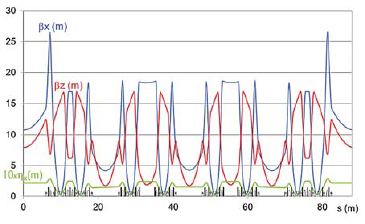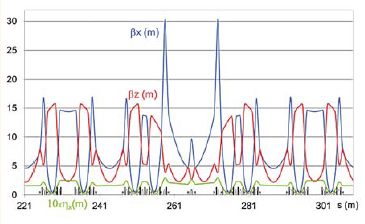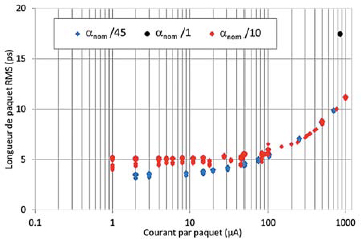The nominal optics of the SOLEIL storage ring has been optimized to satisfy users in terms of electron beam size at «source» points, while guaranteeing an excellent performance with regard to the operation of the machine (lifetime and injection efficiency). There are several reasons that might require changing the opt ics: overcome performance limitations imposed by the undulators and wigglers, meet user needs in terms of beam characteristics, or take into account modifications of the machine for the construction of new beamlines.
What is an optics?
In the storage ring, the focusing system of the electron beam is provided by 160 quadrupoles. Each quadrupole focuses in the horizontal plane and defocuses in the vertical plane, or vice versa. Assembled by two or three, the quadrupoles consist of a focusing system in both planes and the electrons undergo continuous refocusing which gives them an oscillating movement. Verif ication of the optics is done by measuring the number of oscillations per turn in the horizontal and vertical planes, i.e. the horizontal (νx) and vertical (νz)betatron tunes. Setting the gradient of the 160 quadrupoles makes it possible to focus the beam transversely at strategic locations such as the middle of straight sections (undulators) and dipoles. Three parameters are commonly used in accelerator physics to represent this focusing effect, which are the optical functions: βx for horizontal focusing, βz for vertical focusing and ηx for the horizontal dispersion function (path of electrons with energy deviation). The smaller these are, the stronger the electron beam is focused. The magnetic structure of the ring (arrangement of dipoles, quadrupoles and sextupoles) has a 4-fold symmetry that is repeated on the optical functions. Figure 1 shows the optical functions on a quarter of the machine for the nominal optics.
The optical functions associated with horizontal emittance (εx), coupling and energy spread, make it possible to calculate the value of the transverse size and divergence of the electron beam at any location in the ring. Using these optical functions one can also calculate the effect of any magnetic field inserted at a given location in the machine. The linear and nonlinear effects of an undulator, for example, are even more important when the optical functions at the undulator location are large.

Figure 1: Optical functions of the nominal optics for a quarter of the ring from the middle of a long straight section to the middle of the next long straight section. The magnetic structure is shown in black. The βz-function is minimized in the middle of the three medium and the two short straight sections. The horizontal emittance εx is 3,7 nm.rad.
Reduction of the effect of the HU640 undulator on beam lifetime
The HU640 undulator is installed in the long straight section SDL05 and serves the DESIRS beamline. When used with vertical linear polarization (horizontal magnetic field), its nonlinear effects increase with the magnetic field and cause a significant reduction of beam lifetime and injection efficiency. The origin of these effects has been identified from beam based measurements that revealed that the field integrals of the undulator, as seen by the electrons, are abnormally large. A magnetic correction system is currently under study and in parallel, optical functions have been modified in the SDL05 straight section and in the other three long straight sections to maintain the 4-fold symmetry of the optics. The βx-function, amplification factor of the nonlinear effects at large horizontal amplitudes, has been reduced by a factor of 2, the optical functions remaining unchanged elsewhere in the ring. This optics, which has the same horizontal emittance and the same betatron tunes as the nominal optics, significantly reduces the effect of the HU640 undulator, and maintains a lifetime larger than 10 h and an injection efficiency above 60 % even in the presence of other undulators. In addition, the new optical function values in the HU640 undulator improve the quality of the photon beam. This new optics has been in operation on the machine from November 2010 to July 2011.
Installation of two canted1 in-vacuum undulators in the long straight section SDL13
The long straight section SDL13 will host two in-vacuum undulators that will serve the two long tilted beamlines, NANOSCOPIUM and NANOTOMOGRAPHY, leading to a significant change in the machine with the installation of new equipment: four dipole magnets to def lect the trajectory of the electron beam only into the two undulators to separate the two photon beams of the two beamlines, two new position monitors, three quadrupoles and two sextupoles in the middle of the straight section. Indeed, as for all the in-vacuum undulators, the electron beam must be focused vertically, which is not the case in the long straight sections with the nominal optics. The three additional quadrupoles ensure the vertical focusing in both undulators and a new optics has been optimized: the so-called “NANOSCOPIUM” optics. The optical functions in the other straight sections are identical to the nominal ones except in the short straight sections where the βx-function has been reduced to minimize the nonlinear effects of the in-vacuum undulators and wiggler (Figure 2).
The extra quadrupole triplet breaks the present four-fold symmetry of the magnetic structure of the machine and has a very significant impact on the transverse nonlinear dynamics of the electron beam. The experimental optimization of this optics, in terms of lifetime and injection efficiency, has led to choose different betatron tunes. The lifetime measured in the presence of the in-vacuum undulators is larger than the nominal one, demonstrating the beneficial effect of reducing the βx-function in the short straight sections, which has a slight impact on the electron beam size. The quality of the photon beam will not be changed by using this new optics.
The validation of this optics, in the presence of the two in-vacuum undulators, is scheduled for fall 2011.

Figure 2: Variation of the RMS bunch length versus current per bunch for αnom/10 and αnom /45. The RF voltage is 4MV.
Bunch length measurements have been performed using a streak camera.
Short bunch production
A request of the users to work with shorter electron bunch lengths, for the time resolved experiments but also for Coherent Synchrotron Radiation (CSR) in the THz range, led to optimize a “low-alpha” optics. In a storage ring, the electron bunch length depends mainly on the electron energy, on the applied voltage in the radiofrequency (RF) cavities and on the α parameter, the momentum compaction factor. This α parameter characterizes the relative variation in trajectory length, depending on the relative variation in electron energy. For the nominal optics (αnom = 4 .4 10-4), the bunch length at zero current is 15 ps RMS (4.5 mm) for a RF cavity voltage of 3 MV and when the current per bunch increases, the interaction of the electron beam with its environment leads to an increase in bunch length.
One way to reduce the bunch length is to reduce the parameter α by a significant factor. For SOLEIL, an optics has been optimized by Maher Attal (SESAME, Jordan) to reduce αnom by a factor of 10, while maintaining a small horizontal emittance and large longitudinal energy acceptance. The optical functions are very different from the nominal ones, and the implementation of this optics on the machine requires the power supply reversal of one quadrupole and one sextupole families. Two critical points were studied. The first one was the stability of the transverse position (the smaller α becomes, the larger the transfer of energy oscillations in the horizontal plane), obtained by means of the two (slow and fast) position feedbacks. The second one was the injection efficiency. Its low value (10 %) is imposed by the specific nonlinear dynamics of this optics. To avoid frequent injections with poor efficiency, the lifetime was increased to 20 h by enlarging the vertical electron beam size.

Figure 3: Variation of the RMS bunch length versus current per bunch for αnom/10 and αnom /45. The RF voltage is 4MV.
Bunch length measurements have been performed using a streak camera.
Using this optics, the value of α was reduced by a factor of 100 for a current of 2 μA per bunch and bunch lengths of 3.2 ps RMS have been measured at αnom /45. The natural bunch lengthening occurs from 50 μA per bunch and the benefit of the reduction of α, below αnom/10 is maintained until 100 μA per bunch (Figure 3). The production of Coherent Synchrotron Radiation in the THz region has been successfully tested on the AILES Infrared beamline and the optimal current per bunch has been optimized in order to increase by 3 to 4 orders of magnitude the emitted power2. Finally, a hybrid filling pattern, consisting of 20 mA in ¾ of the ring and an isolated 70 μA bunch, should satisfy both types of experiment. This optics is planned to be used in operation on the 10th and 11th December 2011.
